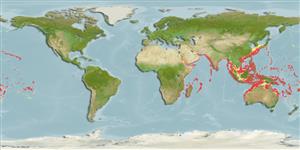>
Eupercaria/misc (Various families in series Eupercaria) >
Lutjanidae (Snappers) > Etelinae
Etymology: Etelis: Greek, etelis, -idos = a fish, perhaps the fish Sparus aurata (Ref. 45335).
More on author: Valenciennes.
Environment: milieu / climate zone / depth range / distribution range
Ecologia
marino associati a barriera corallina; distribuzione batimetrica 45 - 400 m (Ref. 9821), usually 90 - 400 m (Ref. 9821). Deep-water; 38°N - 32°S, 29°E - 139°W
Indo-Pacific: East Africa eastward to the Hawaiian Islands, north to Sea of Japan, south to Australia (Queensland and New South Wales) and Lord Howe Island; off Kermadec Islands, northeast of New Zealand (Ref. 9821). Reported from the Marquesas (Ref. 114223). The name Etelis carbunculus has been misapplied to this species by some previous authors.
Length at first maturity / Size / Peso / Age
Maturity: Lm 66.3, range 52 - ? cm
Max length : 120 cm TL maschio/sesso non determinato; (Ref. 5484); common length : 50.0 cm SL maschio/sesso non determinato; (Ref. 9821)
Spine dorsali (totale) : 10; Raggi dorsali molli (totale) : 11; Spine anali: 3; Raggi anali molli: 8. Interorbital space flat. Maxilla covered with scales. Dorsal and anal fin bases without scales. Upper caudal lobe becoming greatly elongated with increased growth. Scale rows on back parallel with lateral line. Back and upper sides deep pink to red; lower sides and belly pink; fins pink to red.
Adults inhabit rocky bottoms (Ref. 30573) of the continental shelf and continental slope (Ref. 75154). Benthopelagic (Ref. 58302). Feed on small fishes, squids and crustaceans (Ref. 30573). Considered an important food fish in some areas. Marketed fresh and frozen (Ref. 9987). Highly valued for the quality of its flesh (Ref. 11888). Mnimum depth from Ref. 089972.
Life cycle and mating behavior
Maturities | Riproduzione | Spawnings | Egg(s) | Fecundities | Larve
Allen, G.R., 1985. FAO Species Catalogue. Vol. 6. Snappers of the world. An annotated and illustrated catalogue of lutjanid species known to date. FAO Fish. Synop. 125(6):208 p. Rome: FAO. (Ref. 55)
IUCN Red List Status (Ref. 130435)
Threat to humans
Harmless
Human uses
Pesca: elevato interesse commerciale; Pesce da pesca sportiva: si; esca: occasionally
Strumenti
Special reports
Download XML
Fonti Internet
Estimates based on models
Preferred temperature (Ref.
123201): 9.9 - 24.8, mean 17 °C (based on 829 cells).
Phylogenetic diversity index (Ref.
82804): PD
50 = 0.5625 [Uniqueness, from 0.5 = low to 2.0 = high].
Bayesian length-weight: a=0.01660 (0.01348 - 0.02042), b=2.95 (2.89 - 3.01), in cm total length, based on LWR estimates for this species (Ref.
93245).
Trophic level (Ref.
69278): 4.4 ±0.2 se; based on diet studies.
Resilienza (Ref.
120179): Basso, tempo minimo di raddoppiamento della popolazione 4.5 - 14 anni (K=0.12; tmax=20).
Fishing Vulnerability (Ref.
59153): Moderate to high vulnerability (45 of 100).
Nutrients (Ref.
124155): Calcium = 5.05 [2.53, 11.76] mg/100g; Iron = 0.208 [0.098, 0.492] mg/100g; Protein = 18.9 [17.0, 20.7] %; Omega3 = 0.224 [0.114, 0.423] g/100g; Selenium = 12.7 [5.2, 31.1] μg/100g; VitaminA = 35.8 [6.8, 215.2] μg/100g; Zinc = 0.242 [0.151, 0.381] mg/100g (wet weight);
